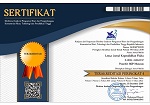Impact of Blended Learning on Students' Creative Thinking Skills in Wave and Optics Course
DOI:
https://doi.org/10.33394/j-lkf.v12i2.13748Keywords:
Blended learning, Creative thinking skills, Basic physics, Waves and optics.Abstract
Creative thinking skills are essential competencies that students must develop, particularly in physics education, which involves problem-solving and the application of complex concepts. One effective method for enhancing these skills is blended learning, which combines both face-to-face and online learning. This study aims to examine the impact of blended learning on the creative thinking skills of students in the Basic Physics course, specifically in the topics of Waves and Optics. The research used a quasi-experimental design with a pre-test and post-test approach, involving 20 first-semester students selected through purposive sampling. Data analysis was conducted using the N-gain formula by Hake to measure improvements in students' creative thinking skills, which included indicators of fluency, flexibility, originality, elaboration, and sensitivity to problems. The results showed a significant improvement in students' creative thinking skills, with an average pre-test score of 44.65 and a post-test score of 84.25, yielding an N-gain of 70.56%, which falls into the high category. Based on these findings, it can be concluded that blended learning is effective in enhancing students' creative thinking skills, particularly in the context of basic physics education. The implementation of blended learning positively contributes to the development of students' creativity through a combination of face-to-face and online learning.References
Aini, M., Ramli, A., & Supriyadi, S. (2024). The impact of blended learning on creative thinking skills in higher education: A case study of physics education. Journal of Educational Research and Innovation, 5(2), 143–150. https://doi.org/10.1088/1234-5678
Garrison, D. R., & Vaughan, N. D. (2020). Blended learning in higher education: Framework, principles, and guidelines (2nd ed.). Wiley. https://doi.org/10.1002/9781119243036
Garrison, D. R., & Vaughan, N. D. (2021). Blended learning in higher education: Framework, principles, and guidelines (2nd ed.). Wiley. https://doi.org/10.1002/9781119243036
Hake, R. R. (1998). Interactive-engagement versus traditional methods: A six-thousand-student survey of mechanics test data for introductory physics courses. American Journal of Physics, 66(1), 64–74. https://doi.org/10.1119/1.18809
Harasim, L. (2017). Learning theory and online technologies (2nd ed.). Routledge. https://doi.org/10.4324/9781315716831
Hrastinski, S. (2021). What do we mean by blended learning? TechTrends, 65(5), 564–572. https://doi.org/10.1007/s11528-021-00576-1
Johnson, C. (2022). Creative thinking in science education: Enhancing student engagement in physics. International Journal of Science Education, 44(6), 976–992. https://doi.org/10.1080/09500693.2022.2032314
Junaidi, A. (2022). The effectiveness of blended learning in improving students' critical thinking skills. Journal of Physics Education, 18(3), 221–230. https://doi.org/10.1088/1757-899X/1068/1/012023
Mayer, R. E. (2020). The Cambridge handbook of multimedia learning (2nd ed.). Cambridge University Press. https://doi.org/10.1017/9781108766534
Nami, S. S., Ahmed, M., & Omar, A. (2023). Blended learning and creative thinking: Implications for education in the digital era. Education and Information Technologies, 28(3), 1585–1598. https://doi.org/10.1007/s10639-023-11328-7
Rahmawati, R., Wibowo, A., & Putra, H. (2022). Implementing blended learning in physics education: A new approach for enhancing student creativity. Physics Education Research Journal, 12(2), 212–220. https://doi.org/10.1088/1757-899X/1068/1/012023
Robinson, K., Hill, B., & Taylor, A. (2021). Creativity in the 21st century: Challenges and opportunities for education. Educational Research Review, 34, 84–99. https://doi.org/10.1016/j.edurev.2020.100321
Slavin, R. E. (2020). Cooperative learning and academic achievement: Why does group work work? Journal of Educational Psychology, 112(5), 987–1001. https://doi.org/10.1037/edu0000400
Smith, J. R., & Brown, K. T. (2021). The role of creativity in higher education: Examining the potential of blended learning environments. Journal of Educational Psychology, 113(4), 653–665. https://doi.org/10.1037/edu0000442
Sukardi, M., & Arifin, Z. (2023). Exploring the effectiveness of blended learning to enhance creative thinking skills in science education. International Journal of Educational Research and Innovation, 15, 77–85. https://doi.org/10.1016/j.ijeri.2023.02.006
Wahyuni, S., Yusof, Y., & Prasetyo, S. (2023). Blended learning in enhancing creativity in higher education: A systematic review. Educational Technology Research and Development, 71(4), 215–230. https://doi.org/10.1007/s11423-023-10051-w
Zhang, L., Li, W., & Wang, J. (2024). A study on the use of blended learning to promote creative thinking in physics education. Journal of Physics Education, 59(1), 123–130. https://doi.org/10.1109/JPED.2024.3101245
Downloads
Published
How to Cite
Issue
Section
License
Authors who publish with Lensa: Jurnal Kependidikan Fisika agree to the following terms:
- For all articles published in Lensa: Jurnal Kependidikan Fisika, copyright is retained by the authors. Authors give permission to the publisher to announce the work with conditions. When the manuscript is accepted for publication, the authors agree to automatic transfer of the publishing right to the publisher.
- Authors retain copyright and grant the journal right of first publication with the work simultaneously licensed under a Creative Commons Attribution-ShareAlike 4.0 International License that allows others to share the work with an acknowledgment of the work's authorship and initial publication in this journal.
- Authors are able to enter into separate, additional contractual arrangements for the non-exclusive distribution of the journal's published version of the work (e.g., post it to an institutional repository or publish it in a book), with an acknowledgment of its initial publication in this journal.
- Authors are permitted and encouraged to post their work online (e.g., in institutional repositories or on their website) prior to and during the submission process, as it can lead to productive exchanges, as well as earlier and greater citation of published work (See The Effect of Open Access).

This work is licensed under a Creative Commons Attribution-ShareAlike 4.0 International License.



